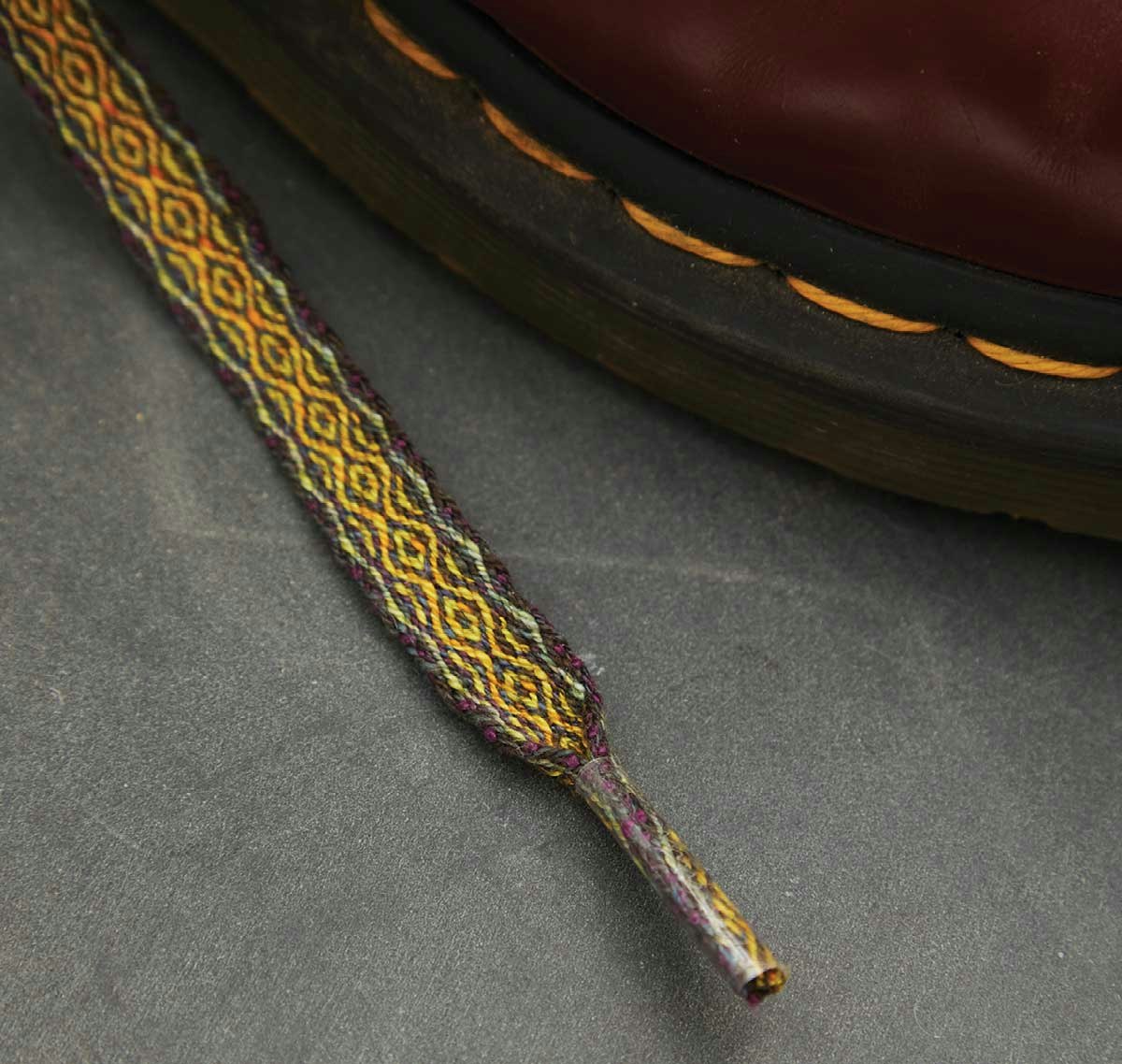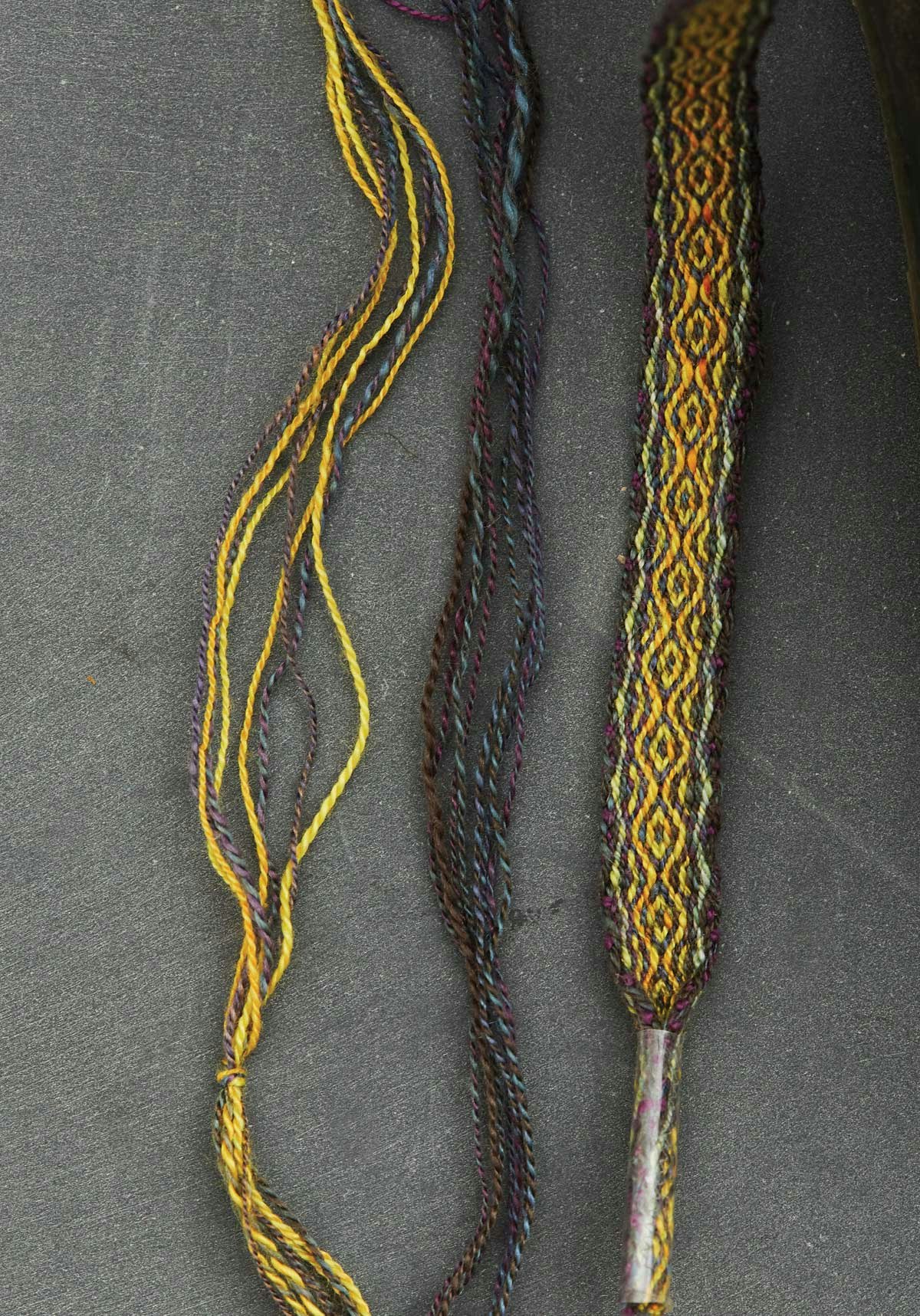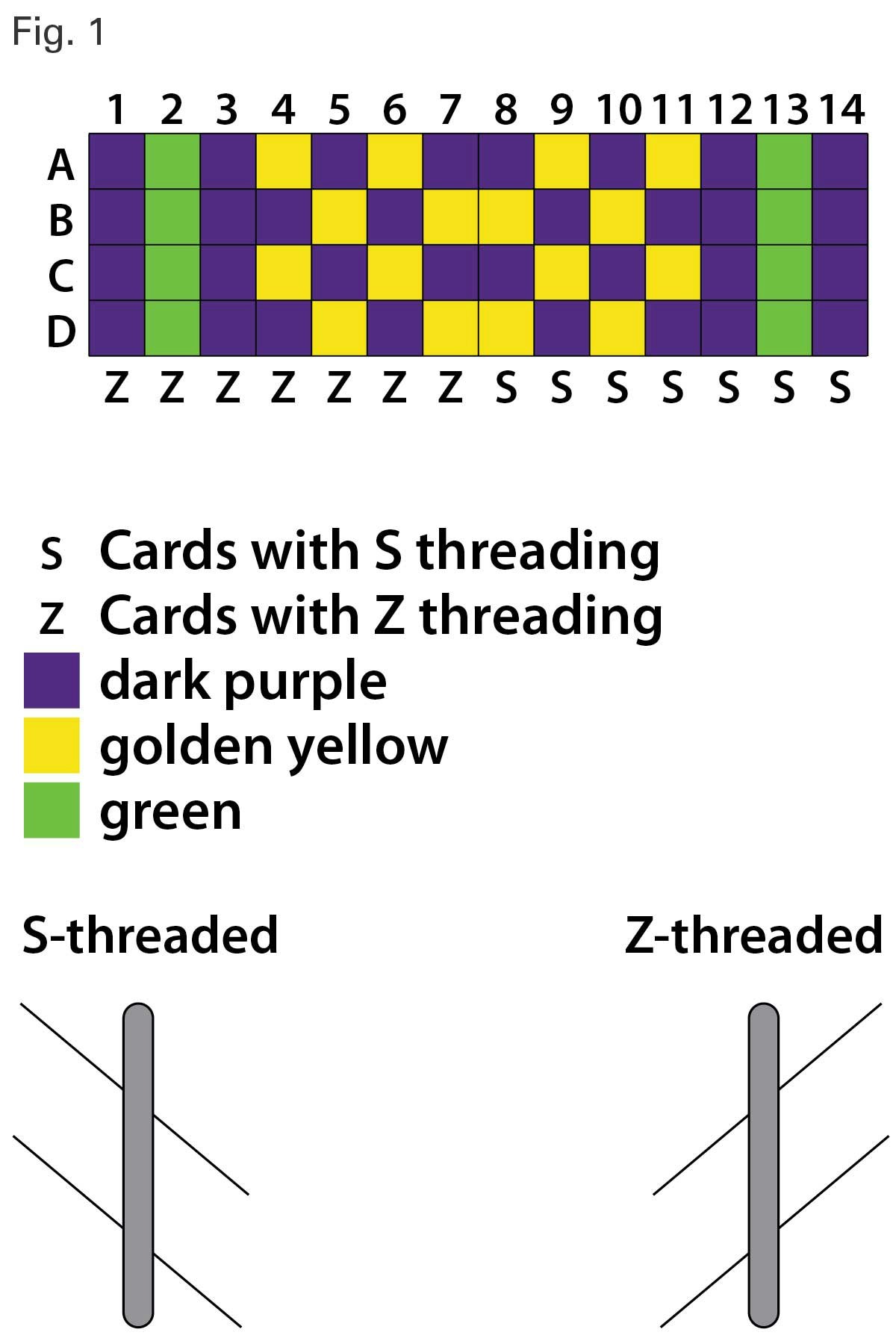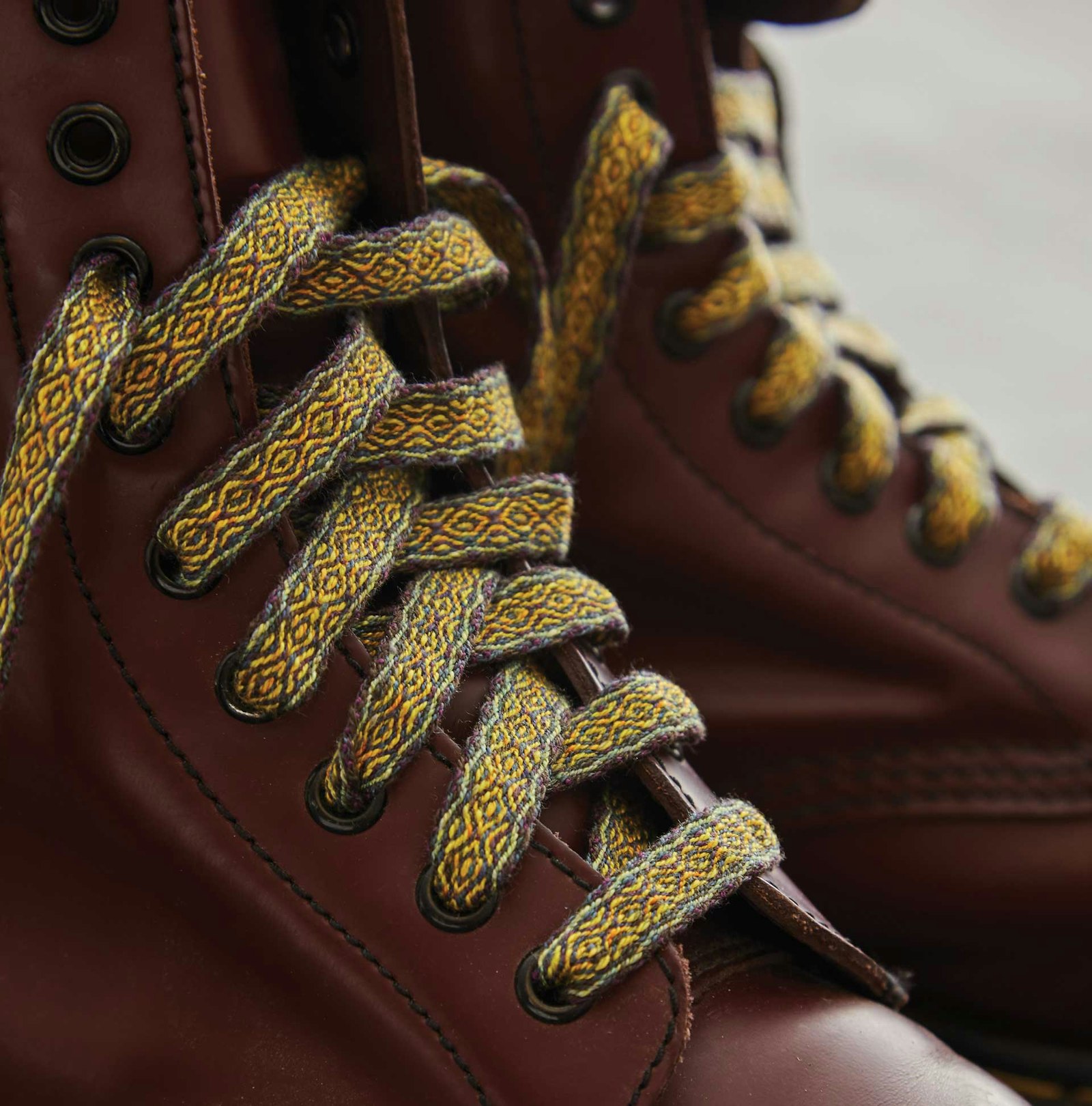Subscriber Exclusive
Luxury Laces
In the Winter 2020 issue of Spin Off, John Mullarkey shared the his handspun, handwoven laces with our readers. Luxurious, indeed!
In the Winter 2020 issue of Spin Off, John Mullarkey shared the his handspun, handwoven laces with our readers. Luxurious, indeed! <a href="https://spinoffmagazine.com/luxury-laces/">Continue reading.</a>
https://spinoffmagazine.com/cdn-cgi/image/format=auto/https://www.datocms-assets.com/75073/1656686141-luxury-laces-1.jpg?auto=format&w=900
I’m often asked, “Why are you weaving shoelaces?” and my answer is always, “Because I can.” But when asked, “Why are you weaving handspun silk shoelaces?” the answer is more involved. Sometimes you have a friend who is worthy of handspun silk shoelaces and who has boots so wonderful they scream for luxury laces. Also, I’ve never made handspun silk shoelaces, so why not give it a try?
Silk is wonderful for tablet weaving because of its strength, and handspun yarns created with hand-dyed silk fiber provide a richness and depth of color you can’t get from dyed yarns. So, yes, it seems like a lot of time to spend on shoelaces, but these shoelaces will last longer than the shoes—I guarantee. As an added bonus, they will greet you with beauty each time you look at your feet!
Project Notes
Shoelaces are a great beginning tablet-weaving project or a fun, quick project for tablet weavers with more experience. This project assumes you already know how to tablet weave, and if you don’t, check out my video Tablet Weaving Made Easy to get started (see Resources).
SUBSCRIBER EXCLUSIVE
I’m often asked, “Why are you weaving shoelaces?” and my answer is always, “Because I can.” But when asked, “Why are you weaving handspun silk shoelaces?” the answer is more involved. Sometimes you have a friend who is worthy of handspun silk shoelaces and who has boots so wonderful they scream for luxury laces. Also, I’ve never made handspun silk shoelaces, so why not give it a try?
Silk is wonderful for tablet weaving because of its strength, and handspun yarns created with hand-dyed silk fiber provide a richness and depth of color you can’t get from dyed yarns. So, yes, it seems like a lot of time to spend on shoelaces, but these shoelaces will last longer than the shoes—I guarantee. As an added bonus, they will greet you with beauty each time you look at your feet!
Project Notes
Shoelaces are a great beginning tablet-weaving project or a fun, quick project for tablet weavers with more experience. This project assumes you already know how to tablet weave, and if you don’t, check out my video Tablet Weaving Made Easy to get started (see Resources).
[PAYWALL]
I like this pattern because it is reversible, which is not easily accomplished with tablet weaving, and it is fairly foolproof. If you get the threading reversed, the same pattern will result because the band is the same on both sides. To weave the pattern shown, turn the cards four quarter turns forward and four quarter turns back, but you can also have fun exploring how the pattern changes by varying the number of turns.
Length and Width
I find that a five-foot lace is a perfect length for boots and high-top sneakers. You can adjust this to accommodate your favorite shoes, but always keep in mind that the take-up in weaving with tablet woven bands is huge. This means that the warp must be much longer than the finished band. A five-foot lace (60 inches) requires about 80 inches of warp.
Creating a sample will allow you to test take-up and ensure that the band will fit your shoes. If the sample band is too large for the grommets on your shoes, you can adjust the pattern to use fewer warp threads and cards to create a narrower band. To finish the ends of the laces, which are called aglets, simply roll the end tightly in clear packing tape.

The firm end of a shoelace is called an aglet.
Spinning Notes
I typically work with Bombyx mori silk combed top, spinning from the tip of the sliver. Bombyx is also often referred to as mulberry or cultiviated silk. Tussah silk is far too fuzzy for tablet weaving in my opinion. (See page 25 for more about different types of silk.)
Because of the abrasion the yarns receive during weaving, I use a lot of twist in the single, and quite a lot of twist when plying. I know I have enough twist in both singles and ply when the finished yarn looks like little beads. I always spin two-ply yarns for bandweaving because the flat nature of a two-ply results in nice flat bands.
After spinning, I wind the yarn into a skein, soak in the sink with tap hot water to set the twist, allow to dry, and I’m ready to weave.

John used hand-dyed bombyx silk combed top to create a complex colorway.
Structure Tablet-woven band.
Equipment Inkle loom with at least four pegs that can accommodate a 2¼ yd warp length; fourteen four-hole tablet weaving cards; 1 belt shuttle.
Yarns 2-ply handspun bombyx silk, 36 wpi, 6,763 ypp.
Warp: dark purple, 72 yd; golden yellow, 36 yd; green, 18 yd. Weft: dark purple, 24 yd.
Warp Length 56 ends 80" long (allows 20" for take-up and loom waste).
Setts Warp: 150 epi.Weft: 28 ppi.
Dimensions
Weaving width: about 3/8".
Woven length: 58–62" including aglet ends when measured under tension on loom.
Finished length: 56–60" including aglet ends.

1 Warp a full-size inkle loom with an 80" warp and 14 tablet-weaving tablets following the tablet weaving draft in fig. 1. Wind a belt shuttle with weft.
2 Weave the band 60" long or desired length, turning the cards 4 turns forward (away from you), then 4 turns backward (toward you). Draw the weft straight across the shed (no angling) so that the width of the band is 1⁄4–3⁄8" and beat firmly with the beveled edge of the belt shuttle after each turn.
3 Remove the band from the loom.
4 Roll each end of the band and the midpoint between the two laces as tightly as possible in clear packing tape. Cut aglets to desired length.
Resources
Mullarkey, John. Tablet Weaving Made Easy video. (2013). Loveland, Colorado: Interweave. www.shop.longthreadmedia.com
John Mullarkey is an internationally recognized author and teacher of tablet weaving. He is constantly pushing this ancient weaving technique into new and contemporary directions. Learn more at www.malarkycrafts.com.




